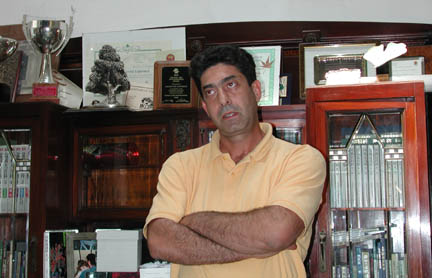| 11 |
2005 -- Yee-Sun Wu died at the Hong Kong Sanatorium and
Hospital. (Wu had been born in 1905 in Shunde City, Guangdong
Province, China. His fascination with penjing began when he was a
small boy. His father, Wu York-Yu, and grandfather, Wu Yee-Hong,
were both enthusiastic practitioners of the "grow and clip" method of
training penjing, which came to be known as the "Lingnan School" --
established by Yee-Hong. [This method, inspired by the contorted
trees shown in early Chinese paintings, seeks to give strength and an
ancient appearance to a dwarfed tree by allowing its branches to grow
and gain caliper and then cutting them back. The method requires
great patience, dedication, careful attention to detail, and a lighter,
more natural approach to the caring of these plants. The grow and
clip technique contrasts with the technique associated with Japanese
bonsai of wrapping branches with wire to bend them to the desired
shape.] The family suffered through a number of disasters and, as
the oldest son, Yee-Sun left Guandong Province to seek work in Hong
Kong to help support his family. In the midst of the depression
in 1933 he began the Wing Lung Money Exchange. By 1949 Wu' s family
had moved to what was then the British colony of Hong Kong, safe from
the destruction that would result in the mid-1960s during the Chinese
[Mainland] Cultural Revolution. As surviving members of the
aristocratic society Wu and some friends were the repository of the
original aristocratic penjing. Wu's small bank grew into
the highly respected Wing Lung Bank with multi-story buildings in
Central Hong Kong and Kowloon. When his health suddenly declined,
he was forced to rest and he rekindled his love of penjing. He
called himself "Man Lung" which means "scholar-farmer." In 1967, he and his friends established Man Lung Garden as a place to meet, to discuss, study, and exhibit. Two years later, he published and distributed Man Lung Garden Artistic Pot Plants, the definitive book on Chinese penjing of the Lingnan style, "fearing that the Chinese art of training pot plants might [otherwise] someday be lost." In 1974 the book was enlarged as Man Lung Artistic Pot Plants with the addition of the history and evolution of artistic pot plants, notes from presentations, and over 100 additional photographs. Some 10,000 copies were donated to leading libraries, universities, and bonsai lovers all over the world to commemorate Wu's retirement from the chairmanship of Wing Lung Bank. (Son Michael Po-Ko, who took over the reins of the company, had studied in New Brunswick and lived in Toronto with his wife and their two children who were born there. Yee-sun himself had previously visited Canada in 1950 and 1967.) Dr. Wu continued the family tradition and was the foremost proponent of the Lingnan School. Over the years, his personal collection in Hong Kong grew to nearly 400 penjing. Many of these he donated to public institutions in Europe and North America, including the Seventh University of Paris (France, 5 trees, c.1982), Montreal Botanical Garden (Canada, 30 trees, 1985, +20 more in 1987), and the Sun Yat Sen Park in Vancouver (Canada). Other trees have gone to the Botanical Park of the Nanjing Institute of the Chinese Academy of Science, the Hong Kong Baptist College (2000) and the Former Governor House of the Hong Kong Government. All of these penjing exhibitions are open to the public. (Ironically, in the 1970s Wu had offered the U.S. 50 of his penjing on the condition that the usual importation procedure of bare-rooting and fumigation be foregone, as this would have been fatal to these very old trees. Unfortunately, the U.S. Department of Agriculture refused to make an exception to its rule even for such a unique offer -- even though the Bicentennial trees from Japan had been excepted earlier. Those trees, however, did yield 23 identifiable pests, so who could say what exotics might lurk in Wu's tropical plants? After a few years of negotiation, the Canadian Department of Agriculture did issue a special phyosanitary certificate for Wu's trees, although two of his magnificent Japanese black pines were refused to be imported. The U.S would receive 24 of Wu's trees in 1986 to begin a two-year quarantine before being put on exhibit.) In addition, Wu would occasionally host individuals and groups from around the world who travelled to see his garden on the beautifully raised terrace fronting his house, which itself was built on a steep mountainside overlooking Hong Kong harbor. Three full-time gardeners were employed at his home. The original Man Lung Garden was forced to close in 1978 when the land was required for a railway station. In 1990, Wu was honored with a Fuku-Bonsai International Honor Roll award. By at least the mid-1990s, he was an inpatient at the hospital where he received constant medical care. He no longer enjoyed the retired life of a scholar-farmer working with his penjing in his garden each day. A new Man Lung Garden was opened at Hong Kong Baptist University in the year 2000 and penjing lovers can gather to discuss and exhibit and the public can enjoy beautiful miniature trees. A website ( http://www.manlungpenjing.org) has begun to put online his fine works, as well as those of other individuals with the objective of continuing the tradition of discussion and exchange of information. Wu instructed his son Norman Po-Man (one of 13 offspring) to take color photographs and publish a hardcover volume as a souvenir for friends who share the same interest and who have loved and supported him. Thus, in 2002, a comprehensive collection of penjing in full color called Man Lung Penjing was published. It serves as a commemorative album celebrating over seventy years of study and as a record of his creative style. The presence of the Wu Chinese Garden Pavilion (1996) at the National Bonsai and Penjing Museum on the grounds of the U.S. National Arboretum testifies to both Dr. Wu's wish to preserve China's seminal role in developing the art form called penjing by the Chinese and bonsai by the Japanese and to his vision that in the 21st century the leading country in the art of penjing and bonsai will be neither China nor Japan but the United States. Because of his great contribution towards the art of Penjing, Dr. Wu is acclaimed internationally as 'Pen Sheng' -- the Sage in the art of Penjing.) 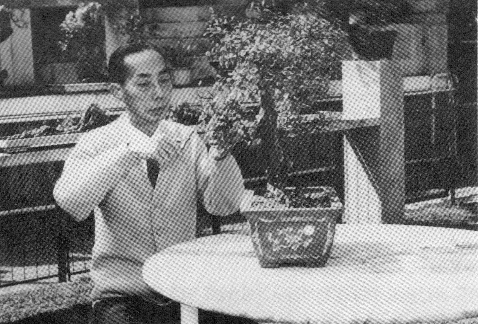
Wu Yee-Sun. (Bonsai Magazine, BCI, Vol. XII, No. 5, June 1973, pg. 27) 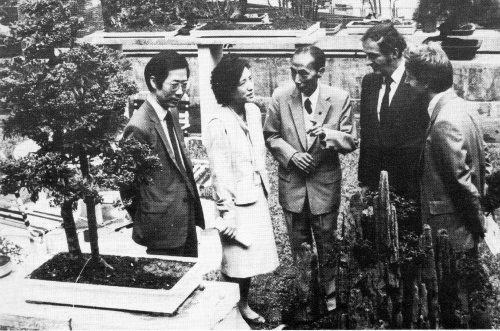
"(L. to R.) Alfred Chui, cargo representative for Canadian Pacific Air in Hong Kong; Chen Ming-lun,
Wu Yee-sun's private secretary,
("Dr. Yee-Sun Wu Biography" by Felix B. Laughlin, August 1995, Updated June 17, 2001,
http://www.bonsai-nbf.org/china/wubio.htm
; "How the Chinese Collection Was Established" by Frederic L. Ballard, September
1985, Updated October 4, 1999,
http://www.bonsai-nbf.org/china/assembly.htm
;"Contribution of Dr. Wu Yee-sun to the Art of Penjing,"
http://www.hkbu.edu.hk/spotlight/content/penjing_contribution2.htm
, "YEE-SUN WU, THE SPIRIT OF MAN LUNG PENJING!,"
http://www.fukubonsai.com/5a16.html,
which erroneously gives his birthyear as 1904 and the second edition date as 1976);
Easterbrook, David "Montreal 1988,"
Bonsai Journal, ABS, Vol. 21, No. 4, Winter 1987, pp. 9-12; Davis, Rosalie H. "A Gift from the East,"
Horticulture,
August 1987, pp. 48-53; "The Tiny Bonsai Trees of Montreal are the Best
in the West -- And That's Certainly Not Going Out on a Limb,"
People Weekly, Apr. 22, 1985, pp. 85-86) SEE ALSO: Mar 16, Mar 27, May 2, Jul 7, Dec 14
Mr. Wu, donor of 30 Penjings of great value; Pierre Bourque, director of the Montreal Botanical Garden; and David Esterbrook, Bonsai specialist of the Botanical Garden and President of the Montreal Bonsai Society." (Bonsai Magazine, BCI, Vol. XXIV, No. 1, January/February 1985, pg. 19, photograph provided by Wilma Swain) 2024 -- Larry Ragle passed away peacefully at his home surrounded by his family. (He started his first three bonsai in 1962 and they were still alive at the time of his death. Larry graduated from U. C. Berkeley in forensic science, and while attending became a Patrol/Investigator for the City of Berkeley. He eventually retired as the Director of Forensic Sciences, Orange County Sheriff-Coroner. He wrote Crime Scene: From Fingerprints to DNA Testing - An Astonishing Inside Look at the Real World of C.S.I. (Harper-Collins, 1995, 2nd Ed. 2002). Larry continued his education and furthered his interest in bonsai. He studied with John Naka beginning in 1966 and then with Harry Hirao in 1974. Harry and Larry created Kofu Bonsai Kai in 1977. Larry was a past president of Golden State Bonsai Federation, California Bonsai Society, and of Kofu Bonsai Kai. He was a member of several Bonsai organizations including Nan Pu Bonsai Kai, John Naka's select club. Larry and his wife Nina founded California Aiseki Kai, a suiseki (viewing stone) club in February 1983. Larry gave a lecture on suiseki in 1986 at the joint ABS-BCI Convention in Washington, D.C.; conducted a seminar at the ABS Convention in 1992 in Hershey, PA; a lecture at the 2nd World Bonsai Convention in 1993 in Orlando, FL and then the GSBF in Irvine, CA; three different bonsai workshops in 1995 at the ABS Convention in Dallas, TX; and a shohin juniper demo and workshop for the 2002 ABS Convention in Milwaukee, WI. He authored the text and wrote the Introduction for Awakening the Soul, a book published in 2000 about the viewing stone collection at the National Bonsai and Penjing Museum. (Nina, a graduate of the University of Wisconsin in philosophy, compiled and edited Even Monkeys Fall Out of Trees, the 1987 book containing 287 of John Naka's Japanese proverbs.) Larry did a suiseki critique at the 2005 GSBF Convention in Anaheim, the couple did the 2007 in Anaheim, Larry did a seminar for the 2009 in Riverside, and lectures ("Stone Collecting In California" and "Keido Study In Japan") and a critique for the 2010 International Stone Appreciation Symposium in PA. Larry was chairman of the GSBF Collection South which established the collection at the Huntington Library and Gardens. He along with others established the California Shohin Society before 2012. Larry made a small number of pots for years and only in the 2010s began selling a few. He was on the Board of Directors for the National Bonsai Foundation, Washington D.C. from its founding in 1982 to 2020. Larry continued to lecture and demonstrate on bonsai and suiseki. Both Larry and Nina studied bonsai display with Susumu Sudo in Japan and have displayed some of their masterpiece stones in the Nippon Suiseki Exhibition in Tokyo, Japan. Editor of California Aiseki Kai's newsletter, Nina has a special interest in suiseki formal display.) [In lieu of flowers, donations were requested for the Larry Ragle Scholarship Fund, which was set up c/o the San Diego Bonsai Club, to advance the education of the Art of Bonsai.]
(FB posting by Nina Ragle on Dai Ichi Bonsai Kai site, May 14, 2024; "Larry Ragle, Co-Founder," ; "Larry Ragle (1982-2020)," National Bonsai Foundation, September 30, 2020; "Larry and Nina Ragle, California," US National Bonsai Exhibition; Dupuich, Jonas "Roundup of American bonsai potters," Bonsai Tonight, November 25, 2016; "Lecture - Legacy of John Naka: Father of Bonsai in America, Sept 7," Cultural News, 2015) SEE ALSO: Mar 12, Sep 4 |
||
| 12 |
1916 -- During the three-day spring flower show of the Massachusetts Horticultural
Society beginning today, Larz Anderson put his collection of dwarfed trees on
public display, apparently for the first time since it arrived in the U.S. from Japan
three years earlier. [The collection would be
awarded first prize and a silver medal.] ("From Temple to Terrace,
The Remarkable Journey of the Oldest Bonsai in America" by Peter Del Tredici
(Jamaica, MA: Arnold Arboretum, Harvard University: Arnoldia 64/2-3, 2006), pg. 22)
SEE ALSO: Apr 13, Sep 20
1988 -- The National Bonsai Collection of Scotland formally opened on a sunny day as Provost Eleanor McLaughlan of Edinburgh cut a raffia strand. In or around 1957, when master butcher Bill Graham of Maybole in the Robert Burns country of Ayrshire retired, he turned his very active mind to a subject which had always fascinated him: the ancient Eastern Art of Bonsai. Books and advice at the time were in very short supply, but gradually over the next several years he developed his knowledge and collection of a staggering 300 trees, often from first principles and often using essentially native species. His unique collection had many visitors. When Bill died in 1983, the trees' care and maintenance posed a major dilemma. Put into the hands of the Local Authority Parks Department of Kyle and Carrick so that some of the trees could continue to be displayed at their Annual Ayr Flower Show (one of the largest horticultural shows in Scotland), the "Graham Trees" were formally and legally gifted by Mrs. Graham in November 1984 to the Scottish Bonsai Association (SBA). This group was initially led by Craig Coussins, who invited Peter Adams to view the trees and offer advice on their development. Many of the trees, however, did not survive the necessary re-potting and rescue. The SBA had begun the process of setting up the first ever National Collection of Bonsai in Britain the year before. In 1986 the SBA was given license to occupy two areas in the gardens at Malleny House, Balerno on the outskirts of Edinburgh -- the Principal Greenhouse and a Shelter -- and the organization became a Charitable Trust. The collection of approximately 36 surviving trees plus a few in the National Collection site itself was awarded a Large Gold Medal that year at the annual Ingliston Royal Highland Show. In early 1988 the first of what would be several pleas went out for additional trees. Alan Roger contributed a 200-year old Chamaecyparis obtusa "nana" in an equally venerable pot to grace the occasion of the formal opening. [Additional trees would be chosen to be accepted into the Collection which features pines, beeches, larches, oaks and other species peculiar to Scotland, as well as a few of the more exotic varieities and the handsome gift of a persimmon from Xian, China, Edinburgh's twin city. In March 2001 the Collection would be the subject of a BBC2tv Programme in the Curious Gardeners' Series.]
Bill Graham (©2002 Scottish Bonsai Association)
("The National Bonsai Collection of Scotland,"
http://www.scottishbonsai.org/National%20Collection.htm
) SEE ALSO: July 15, Nov 22
|
||
| 13 |
|
||
| 14 |
1910 -- The Japan-British Exhibition opened in London. [By its
close on Oct. 29, some 8.3 million people would
have toured its grounds and seen one of its most notable exhibits -- the collection of "pigmy trees" presented by the
Yokohama Nursery Company. The 2,000 plants which ranged from age 25 to 300 years included Thuja obtusa,
Pinus pentaphylla, P. massoniana, Larix leptolepsis, Juniperus procumbens, J. rigida,
Tsuga Sieboldii, Cryptomeria japonica, Acers, Quercus dentata, Styrax japonica,
Lagerstömia indica, Punica granatum, Cerasus, Wistaria, Crataegus cuneata,
Zelkova keakii, Euonymus alatus, Hedera, and Bambusa.]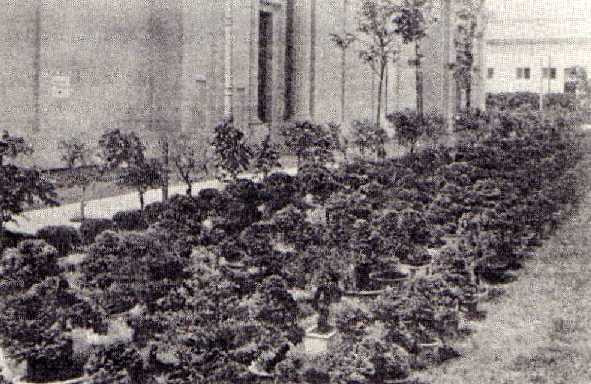
"Pigmy Trees" Exhibited by the Yokohama Nursery Company 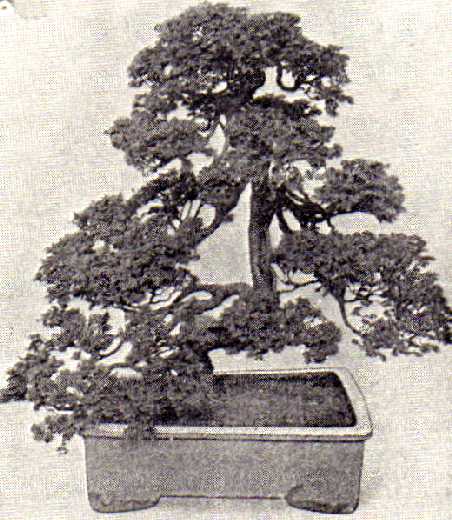
Thuja obtusa, reportedly 125 years old, was awarded a silver cup as the finest example of a pigmy tree. 1929 -- Mikio Oshima was born in Okayama, Japan. [He would become interested in bonsai in 1947 while as an engineer with a construction company. A dozen years later during a job transfer to Nagoya he would study under the well-known teacher, Saichi Suzuki, who lived nearby. Like his mentor, Mikio would specialize in pines, his favorite variety also being the "Zuisho," dwarf Japanese five-needle. (His son would complete a five-year apprenticeship under Saichi's son.) Mikio would author many articles, promote the art on television in his homeland, and act as a consultant on design and training techiques. He would teach year round in his Okayama garden studio, having several part-time apprentices assist him with his ongoing series of experiments on his many trees, whether it be to determine the best way to propagate a variety or the best day in the year to bud prune Japanese black pine bonsai.] 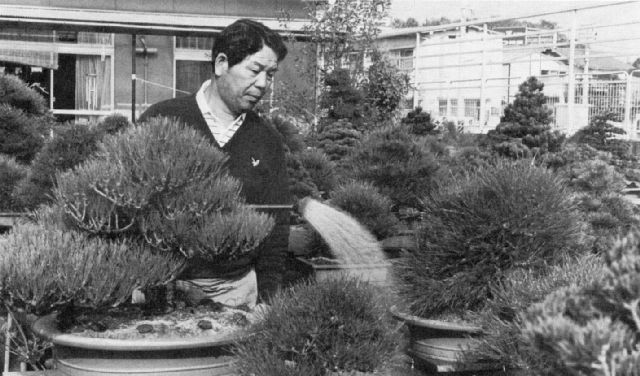
"Mikio Oshima watering Japanese black pine bonsai."
("Mikio Oshima" by William N. Valavanis,
International Bonsai, IBA, 1983/No. 1, pp. 16-17; Mikio Oshima biography,
International Bonsai, IBA, 1986/No. 2, pg. 13) SEE ALSO: Jan 28
(Photo by W.N. Valavanis) (International Bonsai, IBA, 1983/No. 1, pg. 16)
1972 -- The California Bonsai Society held its 15th Annual Exhibition
beginning today and running through the 28th. This was in conjunction
with the 50th Anniversary of the Museum of Science and Technology which
sponsors the event. There was a special feature showing of loaned
bonsai from the Japanese Imperial Household. [In conjunction with
the show, on May 20 the County of Los Angeles would award John Naka a commendation
"for his outstanding contributions to the Japanese-American friendship,
by providing the people of Los Angeles and the Nation with the ability
to understand and appreciate the beauty and significance of Bonsai Culture."]
(Bonsai Magazine, BCI, December 1971, pg. 4;
Bonsai, BCI, July/August 1978, pg. 197) SEE ALSO Mar 3, Apr 10.
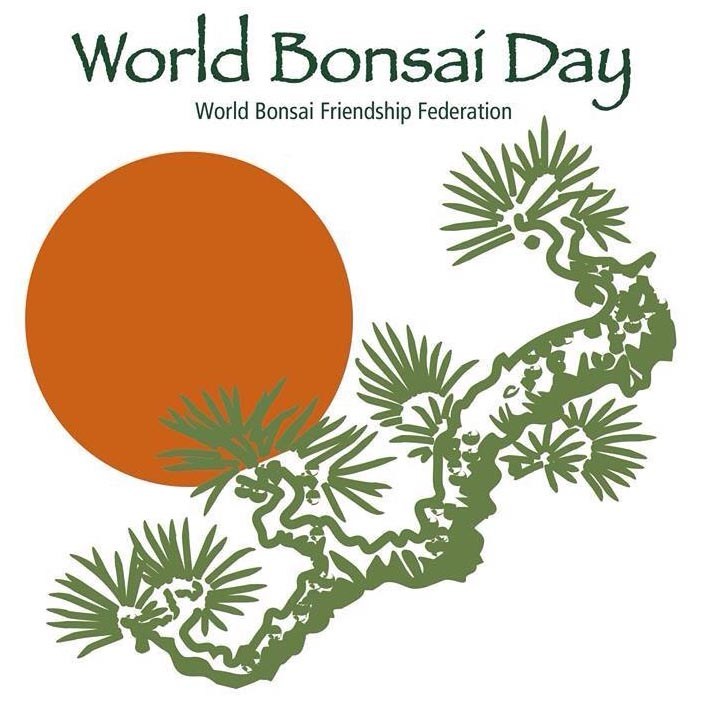
|
||
| 15 |
1915 -- Tomekichi Katō, an outstanding master and second-generation proprietor of the
Mansei-En Bonsai Garden, welcomed his firstborn son, Saburō, into the world.
[The child would grow up assisting his father in clearing the forest for the Omiya Bonsai Village in the mid 1920s,
help develop the techniques for successful cultivation of Ezo spruce (Picea glehni) as bonsai in the 1930s,
and, after the elder's death in 1946, manage the family business as a prelude to his eventual international
influence on the art.]
("Saburo Kato: The Gentle Spirit of International Bonsai and Peace" by David W. Fukumoto,
Bonsai Journal,
ABS, Vol. 22, No. 4, Winter 1988, pg. 6.) SEE ALSO: Jan 4, Apr 19, May 14, Oct 15, Nov 3, Nov 20
1950 -- Brussel Martin was born. [When he would be five years old, he'd be instantly captivated by several species of bonsai his father would bring back from a California business trip. As a teenager, he would begin to seriously study the art of bonsai. What started as an artistic endeavor in his parents' backyard would quickly grow into a business when, in the 1970s, Brussel would found a small nursery (originally in the Memphis suburb of Germantown), begin selling bonsai through the mail, and travel to shows across the country. In the early 1980s he would be making annual buying trips to Asia, supplying his larger nursery in Olive Branch, MS. (This is some twenty minutes south of Memphis, which is in southwestern Tennessee with a Federal Express airport hub.) Beginning in 1987 he would host a Spring Rendezvous with various national and internaltion teachers conducting the workshops. Brussel also occasionally would lecture and demonstrate at various club meetings and other bonsai venues. In 1990 he would donate a Trident maple forest (Acer buergerianum) to the U.S. National Arboretum North America Collection. Brussel's Bonsai Nursery would become the largest importer and grower of bonsai in America on 18 acres with offices, retail store, bonsai library, display gardens, greenhouses, packing facility and shipping area. About 90 percent of the nursery's business would be conducted nationally over the Internet and would have very little walk-in business. Pots, tools and accessories would complement the trees ranging from novice starter material to master specimens. See also this Art of Bonsai Project Interview.] 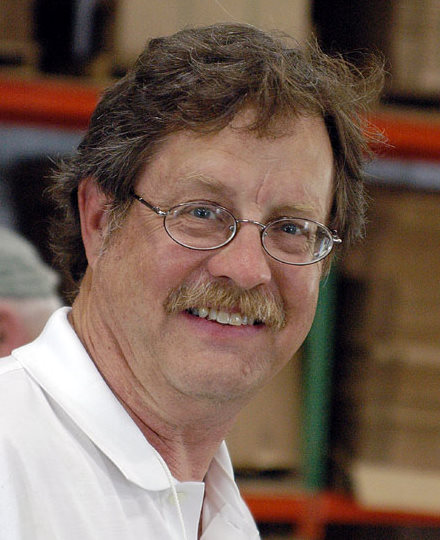
Brussel Martin, 061206.
("Brussel's Bonsai Nursery,"
http://www.youtube.com/watch?v=AmyRdflQu-g;
Covington, Jimmie "Brussel's Nursery is place for bonsai," May 25, 2008,
http://www.commercialappeal.com/news/2008/may/25/bonsai-to-behold-brussels-nursery-is-place-for/?feedback=1;
"The Story of Brussel's Bonsai Nursery," "Product Description,"
http://www.amazon.com/Brussels-Japanese-Red-Maple-Bonsai/dp/B0000DGG55;
"Welcome," "SeaClaire Enterprises,"
http://www.seaclaire.com/;
Shaw, Jess "The History of Brussels Bonsai," article cube
http://www.articlecube.com/Article/The-History-Of-Brussels-Bonsai/388948.)
SEE ALSO: May 23
(Photo by Walter Pall, courtesy of Alan Walker, 05/11/07)
1958 -- Salvatore Liporace
was born in Belvedere Marittimo (Cosenza), southwest Italy (just above the "toe" of the "boot." [He
would establish a school entirely devoted to bonsai, the
Studio Botanico
in Milan, in 1986 and it would become well known as a center of excellence in Europe. His
students, devoted to him and to his philosophy of "becoming one" with the
tree, would successfully compete in the European Bonsai Association New
Talent Contest and the BCI Ben Oki International Design Award competition.
Salvatore would teach bonsai on radio and television, perform demonstrations
and hold workshops -- even at the University of Architecture in Milan and
the University "La Sapienze" in Rome. Contributing articles to European
and American bonsai publications, he would also be a founding member and
board member of the Collegio Nazionale Istruttori Bonsai e Suiseki (IBS). He would go on to become
the first bonsai artist with schools in the USA, Spain, Portugal, France, Puerto Rico, Brazil, Poland,
and Italy.]
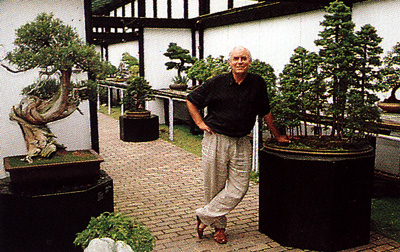
Paul Lesniewicz
(photo from Peter Krebs' tribute page) 
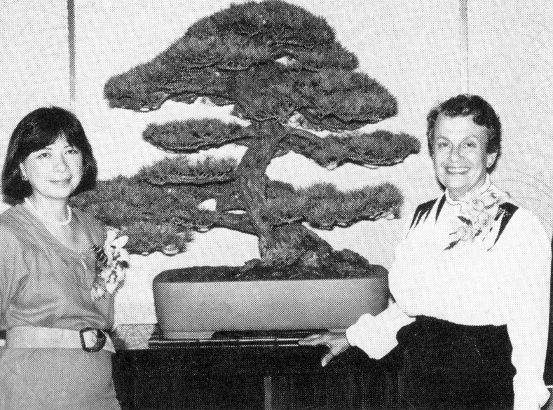
"Incoming BCI President Donna S. Banting.
Outgoing President, Jean C. Smith" (Bonsai Magazine, BCI, Vol. XXV, No. 6, November/December 1986, pg. 19) 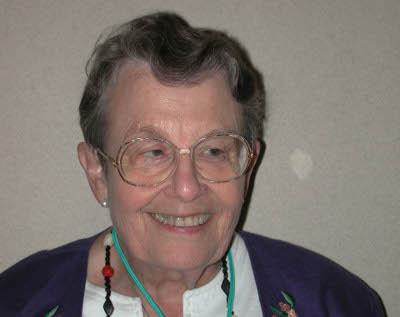
Jean Smith, 07/05/2002.
(Fabian, Lynn "Jean Carroll Smith 1925 - 2009", Bonsai Societies of Florida, May 18, 2009,
http://web.archive.org/web/20100307015858/http://www.bonsai-bsf.com/news/Jean_Carroll_Smith)
SEE ALSO: Dec 17
(Photo courtesy of Alan Walker, 05/11/07) 2011 -- Daizo Iwasaki passed away at age 94. (He spent his life sharing his love and passion of bonsai with the entire bonsai community. A native of Shikoku Island in southern Japan, he grew up surrounded by trees and plants cared for by his grandparents. He often collected seedlings for future bonsai. Upon his return from Mainland China after being drafted for the Pacific War, Iwasaki decided to grow bonsai to comfort his uneasy state of mind during the war. Over a two year period he sowed 12.8 million Japanese five-needle pine seed from nearby Mt. Ishizuchi in a watermelon field he owned. Less than half germinated -- but he still had some 5 million to be cultivated for bonsai in his fairly simple unnamed nursery. In July 1993 Takasago-An Bonsai Garden at his home in Niihama on the north-central coast of Shikoku Island was formally named and opened. This was truly the most spectacular garden in the world of bonsai, a paradise of masterpiece bonsai and beautifully trained garden trees (many imported) in the Japanese garden with collected antique stone lanterns, stepping stones and basins which surround the reception house. A mountain stroll garden was built up; several garden areas devoted to roses, peonies, chrysanthemums, and other flowers were added; a large Koi pond was dug and enlargened a year later; a famous old tea house was restored on the property. On the grounds Iwasaki had collected 30,000 specimens, 100 of them of high quality and 20 deemed "important masterpieces" by the Nippon Bonsai Association. He employed over 20 people to care for all of this, including artist and skilled grafter Yuji Hoshikawa. Iwasaki's favorite trees included Seidai, a 300-year-old Japanese black pine (Pinus thunbergii) collected during the Taisho era (1912-26) and exhibited nationally in 1970. The "Takasago-An Dry Landscape Garden" was created to express the deep traditional Japanese culture with the lush mountain green of the magnificent Shikoku Mountain Range region (opposite the Inland Sea) as a background. In this garden there are numerous famous old trees such as the Shimpaku (Juniperus chinensis var. sargentii), Pine (Pinus spp.), Ichii (Taxus cuspidata), Maki (Podocarpus macrophylla), Tosho (Juniperus rigida), Hiragi (Osmanthus heterophyllus), and Gaya as well as stone lanterns which are about 300-1000 years old. In addition, there are 500 trees which are 150-200 years of age and arranged to evoke the "53 stages of the Tokaido road" paintings drawn by the famous Edo-era artist, Hiroshige. The dry landscape garden was arranged with rocks and sand to express the flow of the water in a river. Iwasaki's wife Naemi is a bonsai connoiseur and was also a Vice-President of the World Bonsai Friendship Federation. Iwasaki was chairman and chief executive of Nangoku Sangyo, which owns and manages leisure and real estate properties in Japan, Hawaii, Guam, and other locales. In 1995 he published a limited-edition book Japanese and English in which he wrote that he had collected "items according to my preference and not according to the value of the bonsai." Although Iwasaki was elderly he was still active with bonsai activities and traveled throughout the world promoting and supporting the hobby he was so passionate about. At the time of his death he was the Organizing Committee Honorary Chairman of the 11th Asia-Pacific Conference, scheduled to take place 18 - 21 Nov 2011 some 50 miles to the east at Takamatsu. A visit to his garden was scheduled to happen on the last day of this ASPAC. A Danish interview with English subtitles can be seen here.)
Daizo Iwasaki, 07/12/05, by Morten Albek.
("Sad News For the Bonsai World," Internet Bonsai Club forum posting by William N. Valavanis, May 19, 2011,
http://ibonsaiclub.forumotion.com/t6651-sad-news-for-the-bonsai-world;
Lambert, Emily with Kiyoe Minami "Bonsai!" Forbes Asia Life, 13 Feb, 2006,
http://www.forbes.com/global/2006/0213/074A.html;Valavanis, William N.
"A visit to the Takasago-An Bonsai Garden of Daizo Iwasaki," International Bonsai, 2011/No. 1, pp. 20-25;
"A message from the Honorary Chairman of the World Bonsai Friendship Federation," Feb 7, 2011,
http://bonsai.shikoku-np.co.jp/en/aspac/2011/02/a-message-from-the-honorary-chairman-of-the-world-bonsai-friendship-federation.html)
SEE ALSO: May 26.
(Photo courtesy of Alan Walker, 05/11/07) |
||
| 16 |
2004 -- Wilma Swain died. (She was from Washington state where
she graduated with a Masters in Science in Botany. She married a
Canadian biochemist, Lyle A. Swain, and lived in Prince Rupert and
later Vancouver. Wilma loved to travel and studied bonsai for a
year in Japan and China. She became active in the Toronto Bonsai
Society and taught bonsai at the Japanese Canadian Cultural Centre in
Toronto. She was employed as a junior high school librarian
She was elected to the board of directors of Bonsai Clubs International
in the 1970s. Wilma then served as its recording secretary, 3rd
vice-president (1977-78), 2nd v-p (1979-80), 1st v-p (1981) and
president (1982-83).)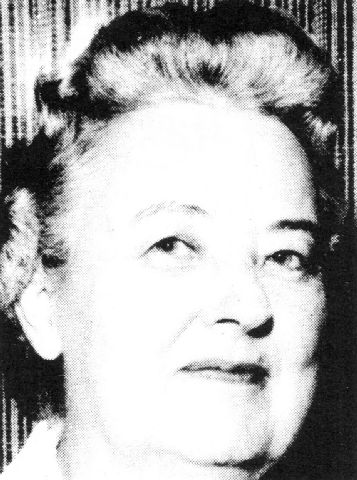
Wilma Swain (Bonsai Magazine, BCI, January/February 1984, pg. 19)
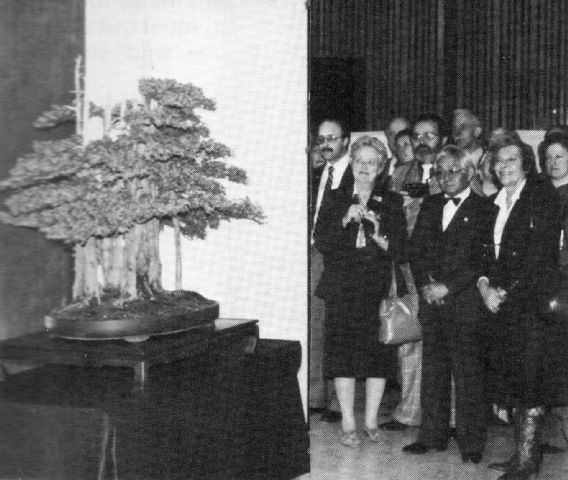
NBF Reception to Honor John Y. Naka, March 7, 1984,
("Bonsai News & Notes," submitted by June Campbell of Canada,
Bonsai Magazine,
BCI, Vol. 43, No. 3, July/August/September 2004, pg. 46; "BCI'S Canadian
Vice President," Bonsai Magazine, BCI, Vol. XVI, No. 8, October 1977, pg. 240)
front row L to R: Wilma Swain, John Naka, Marion Gyllenswann Bonsai Magazine, BCI, May/June 1984, pg. 27) |
||
| 17 |
1961 -- This year's Chelsea Flower Show
opened to the public today
(to Fellows and Associates of the Royal Horticultural Society yesterday)
and ran until the 19th. Six bonsai trees were imported especially
from Japan for the purpose of being exhibited for the first time at this
famous event in London. [The general public would be so interested
in the trees that Ian Melville Clark, who organized the exhibit, would
arrange a meeting for all interested parties. As a result of this
meeting, the Bonsai Group -- later renamed Bonsai Kai
-- of the Japan Society of London would be formed. From that beginning, the group would exhibit
at the Chelsea Show every year. At the 1973 and 1974 shows the group's
displays would win the top award of a gold medal.]
("Bonsai at the Chelsea Show," Bonsai Journal, ABS, Vol. 9, No. 3, Fall 1975,
pp. 64-65 with three b&w photos from 1974 Show; private e-mail to RJB
from Clare Greene of the RHS, Sept. 19, 2003) SEE ALSO: Nov 6
2002 -- The Katō Stroll Garden was officially dedicated as part of the International Scholarly Symposium on Bonsai and Viewing Stones, which would run through the 19th at the National Bonsai and Penjing Museum at Washington, D.C.'s National Arboretum. The garden, most prominently colored by maples and blooming azaleas, honored the five generations of bonsai enthusiasts of the Katō family in Japan who have done so much to promote the art throughout the world. [Some 161 persons from the U.S., Japan, Canada, Italy, and the Netherlands would participate in the Symposium, which would be rescheduled from the end of Oct. 2001 due to the events of September 11. The Symposium was generously underwritten by Mary E. Mrose.] (RJB and program page from the International Scholarly Symposium on Bonsai and Viewing Stones, May 18, 2002, Washington, D.C.) SEE ALSO: Mar 27, May 2, Jun 9, Aug 26, Sep 30, Oct 1, Oct 15 |
||
| 18 |
|
||
| 19 |
1993 -- Katherine (Kathy) Shaner of San Jose, CA became the first non-Japanese citizen and the first woman to be awarded
a certificate of Bonsai Master (sensei) by the Nihon Bonsai Kyodo Kumiai. Kathy received one of only three
certificates awarded that year. (She originally had wanted to improve her home landscape and, not finding a course
on Japanese Gardens, registered in 1983 for a local adult education course in bonsai. Through those sessions she
located the Midori Bonsai Club. She and her husband Alex
went on to join ten California clubs to learn under a variety of masters and teachers. The
Golden State Bonsai Federation's then fledging intern education
program made it possible for Kathy, beginning on June 26, 1989, to apprentice with Yasuo Mitsuya, one of Japan's outstanding
artists and highly regarded there as a master of Gendai (contemporary form) bonsai training. Mitsuya-san
had been the very first student of Toshinori Suzuki -- and thus Toshinori's father and teacher Saichi also was involved in
his education. Excerpts from the diary Kathy kept while at the
Toyohashi-City, Aichi
Prefecture nursery, Tokai-en, were published in issues of the GSBF Golden Statements and ABS Bonsai Journal (Eight parts from
Spring 1991 through Winter 1992). Toyohashi is about 148 miles (239 km) west-southwest of Tokyo and 94 miles (152 km)
east-southeast of Kyoto. Activities would include yard work, tree work on mostly conifers (especially black pines and needle junipers, tosho,
sensei's favorite) and varying with the season, going to clients to work on trees, moving trees before approaching typhoons,
prepping trees and stands for shows and taking same to shows, sightseeing, studying old books and magazines; some cooking,
housework, puppies, and various persons' health issues.) [Returning to the U.S., she would become a sought-after speaker and demonstrator. She would use her knowledge and ability to find the "soul of the tree" (as Mr. Mitsuya would put it) to teach her students in a clear and understandable way. In her own words, to "be able to read the storyline of the tree," and if you understand the story [of how nature shapes the tree], you can get the tree to develop along the lines of that story. Her many bonsai activities would include conducting seminars, full-day workshops, critiques, lecturing on-site and working on private collections throughout the United States. Kathy would be the resident bonsai master at the El Dorado Bonsai School which would open in early 1999. Sitting among the trees on a beautiful 52-acre campus in Placerville, California, this would be the first bonsai school in the United States to feature Japanese-accredited bonsai master instructors. She would also be the curator of the 150-tree Golden State Bonsai Collection-North at Lake Merritt in Oakland, California which would open in the fall of 1999. She would be a featured speaker at the 2004 BCI Convention, the 5th World Bonsai Convention in 2005, the 1st U.S. National Exhibition in 2008, and a guest artist each year at the annual Rendezvous held by Brussel's Bonsai Nursery. Internationally-renown bonsai master Yasuo Mitsuya, teacher to many students in California and other states such as Kenji Miyata, Dennis Makishima, Cheryl Manning, Boon Manakitivipart, David DeGroot, and Gordon Deeg, would occasionally teach in the Golden State alongside Kathy.]
Kathy Shaner with a Boxwood, 06/18/2004.
(Bonsai Today, No. 27, pg. 4; "Profiles Of The Stars At IBC '94, Part II," Bonsai Magazine, BCI, Vol. XXXIII, No.
4, July/August 1994, pg. 16; Shaner, Kathy "Diary From Japan," "Editor's Note" and "About the Author," Bonsai Journal, ABS, Vol. 25, No.
1, Spring 1991, pp. 18, 21; conversation with Kathy by RJB 06/19/2010, Rocky Mountain Bonsai Society show;
"Kathy Shaner," 5th World Bonsai Convention,
http://www.bonsai-wbff.org/wbc5/presenters/shaner.htm;
"GSBF Bonsai Garden at Lake Merritt,"
http://www.gsbf-bonsai.org/lake-merritt/Mitsuya_atBGLM.htm;
"Special Educational Programs," "Carolina Bonsai Expo,"
http://www.ncarboretum.org/plan-a-visit/event-calendar/carolina-bonsai-expo)
SEE ALSO: Jan 28, May 20, May 23, Oct 11, Nov 6(Photo courtesy of Alan Walker, 05/11/07) 2004 -- Grandmaster John Yoshio Naka died at the age of 89. |
||
| 20 |
1916 -- Miyagawa (Makuzu) Kōzan died in Dangozaka, Tokyo. (He had
been born in Kyoto into a potter's family as the 4th son of Nagaheiei (Makuzu
Chōzō) on Jan. 6, 1842. He came from a long line of potters based
in Kyoto and took over the family business in 1860, at the age of eighteen when
both his father and older brother died within a short period. In
1870 Kōzan moved to Yokohama and the following year he opened the
Majuzu Kiln for his workshop. At the time, china
and porcelain were leading export items. Products designed for
export were being created in areas throughout Japan in keeping with
the national policy of "enriching the nation and strengthening the
army" to transform Japan from an isolated feudal state to a modern
nation by the acquisition of modern industrial technology from the
West, the promotion of Japanese culture abroad, and the encouragement
of international commerce. Kōzan
seems to have arrived at his artistic height during the 1880s.
In the earlier days he managed successfully to cater to new foreign tastes
using largely traditional methods, and then when export figures
plummetted by the early 1880s he turned back to the domestic market and
took advantage of newly imported Western technology to create novel
styles of high-fired, glazed porcelain designed to appeal to the
changing tastes of the Western market. He transferred his Makuzu
Kiln to Hannosuke in 1888. In 1896 he was appointed as an
Imperial Artist. Kōzan
received many awards throughout the Meiji Period. At the 1876
Philadelphia Centennial Exposition he participated for the first time
on the international arena and he received a bronze medal. At the
1878 in Paris International Exposition, he was given the gold; 1879
Sydney, Australia, the silver; 1880 Melbourne, the bronze; 1883 Amsterdam, the
silver; 1888 Barcelona, the silver; 1889 Paris, the gold; 1893 Chicago,
the gold; 1894 San Francisco, the gold; 1900 Paris,
grand prix
; and the 1904 St. Louis, the honorary grand prize. He also
exhibited at the 1905 Liège; the 1909 Seattle; the 1910
Japan-British; and the 1915 San Francisco. [cf.
Expositions
known to have had bonsai present] Plus he participated at a dozen
major exhibitions in Japan and served on a number of societies and
associations to further various arts. He was one of the few
Japanese potters to escape the
first-time-ever criticism in 1900 Paris, which was a watershed for
Japanese ceramics. Art Nouveau was then the new influential design
movement in Europe which advocated singleness of design and unity of
vessel shape and decoration. This stimulated calls for improvement in
design quality within the Japanese ceramic industry and an intense
internal debate over the role and function of ceramics. A pioneer
in the field of ceramic design, Kōzan was stimulated by the Paris
Exposition to extend the creative boundaries of his ware even further. He
continued to produce works of art until his death. Pieces signed "Makuzu
Kōzan" in various hands seem to have been made right up until the
first decades of the 20th century. In the world of pottery, Kōzan
led the field from the start of the Meiji Period to the very end (1868 - 1912).)
[Hanzan (Kōzan's stepson and nephew, born Hannosuke) would take charge of the studio in 1917, although he had much influenced the output from circa 1895. Hanzan would have two sons: Katsunosuke (aka Kōzan III), who would do little to drive the studio forward between 1940 and his death during the bombing raid on Yokohama in 1945 (which would also destroy his kiln and showroom and kill his family and employees), and Tomonosuke (aka Kōzan IV, younger brother to Kōzan III), who would revive the kiln and head the studio until his death in 1959. At that time the Makuzu workshop would close forever.] 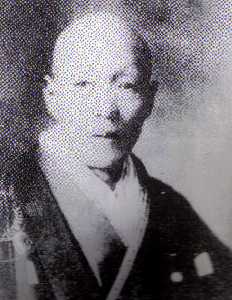
Why this is important to us: One of the greatest potters of the Meiji Era, Kōzan was also renowned in certain circles for his bonsai pots, but he sold them under very special conditions. He only made these pots on order, and only if the buyer promised not to keep any bonsai in them. As a result there were very few bonsai pots made by this remarkable potter, and only a very few exist today. (Bonsai Today, No. 20, pg. 64 which lists name as Shinkatsu Kazan; correction in Bonsai Today, No. 22, pg. 4; "Japanese 'Makuzu Kozan' piece", http://www.gotheborg.com/index1.htm?http://www.gotheborg.com/qa/duckvase.shtml ; Kazuo Seki and Kazuo Yoshida "An Outline of Miyagawa Kozan and his Works," http://tanutech.com/japan/kozan.html ; Pollard, Clare Master Potter of Meiji Japan, Makuzu Kōzan (1842-1916) and his Workshop (Oxford University Press, 2002), pp. 4, 77, 80, 87, 116, 146-150; image from pg. 2) 1984 -- The first episode of a 13-part series "The Art of Chinese Bonsai in Taiwan" was broadcast on public television there. The narration was provided by Prof. Amy Liang and the series was originally shown over a four month period. Part of a government sponsored national plant-beautification project, the series was re-telecast due to an overwhelming viewer response. [The series would run for two years, and give rise to an upsurge of interest in bonsai art in Taiwan.] (The Living Art of Bonsai by Amy Liang, Sterling, 1992, pg. 106; "A Legendary Bonsai Master and Her Museum" by Billy Shyu, Nspirement.com, November 8, 2017) SEE ALSO: Mar 4, Jun 1, Nov 3 1991 -- Bonsai master Saichi Suzuki died in Okazaki, Japan at age 89. He was one of the foremost authorities on pine bonsai and introduced the "Zuisho" Japanese five-needle pine. (Valavanis, William N. "Through the Pine Needles," International Bonsai, IBA, 1991/No. 3, pg. 3) SEE ALSO: Jan 28, Jan Also, May 14 |
